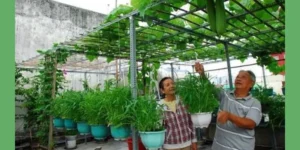Mushrooms popping up in your potting soil? While often harmless, they can be unsightly and sometimes a sign of underlying issues. Understanding why these fungal growths appear and how to manage them is crucial for maintaining healthy indoor plants.
In this guide, we’ll delve into the world of mushrooms in potting soil, exploring their causes, potential impacts, and effective prevention and treatment methods. By the end, you’ll have the knowledge to keep your plants thriving and your potting soil mushroom-free.
Understanding Mushrooms in Potting Soil

Mushrooms as a Sign of Organic Matter
- The role of fungi in soil ecosystems
- Mushrooms as the fruiting bodies of fungi
- The presence of mushrooms indicating organic content in potting soil
Beneficial vs. Harmful Mushrooms
- Differentiating between beneficial and potentially harmful fungi
- The role of beneficial fungi in plant health
- Identifying signs of harmful fungal activity
Conditions Promoting Mushroom Growth
- Ideal conditions for mushroom growth: moisture, temperature, and organic matter
- Overwatering as a primary factor in mushroom proliferation
- Poor drainage and its contribution to mushroom growth
Impact of Mushrooms on Plants
- Do mushrooms directly harm plants?
- Indirect effects of mushrooms, such as competition for nutrients
- When to be concerned about mushroom growth
Preventing Mushrooms in Potting Soil
Sterilization of Potting Soil
- Benefits of sterilizing potting soil
- Methods of sterilization (heat, microwave, oven)
- Precautions and considerations for sterilization
Proper Drainage and Aeration
- Importance of well-draining potting mix
- Creating adequate drainage holes in pots
- Using materials like perlite or vermiculite to improve aeration
Avoiding Overwatering
- Signs of overwatering
- Watering techniques to prevent excess moisture
- Allowing soil to dry slightly between waterings
Using Pasteurized or Pre-Sterilized Potting Mix
- Benefits of using commercial potting mixes
- Checking for pasteurization labels
- Considerations when choosing a potting mix
Dealing with Mushrooms in Potting Soil
Removing Mushrooms Manually
- The importance of removing visible mushrooms
- Preventing spore dispersal
- Tools and techniques for removal
Adjusting Watering Practices
- Reducing watering frequency
- Improving drainage
- Allowing soil to dry out between waterings
Using Hydrogen Peroxide Solution
- Benefits of hydrogen peroxide as a natural fungicide
- How to apply hydrogen peroxide to potting soil
- Precautions when using hydrogen peroxide
Repotting as a Last Resort
- When repotting is necessary
- Choosing a fresh, sterile potting mix
- Inspecting plant roots for signs of disease
Conclusion
While the appearance of mushrooms in potting soil can be alarming, it’s important to remember that they are often a natural and harmless byproduct of organic matter decomposition. However, excessive mushroom growth can indicate underlying issues such as overwatering or poor drainage.
By implementing preventive measures like sterilizing potting soil, ensuring proper drainage, and avoiding overwatering, you can significantly reduce the likelihood of mushroom growth. If mushrooms do appear, manually removing them and adjusting your watering practices can often be sufficient.
In severe cases, repotting with fresh, sterile potting mix may be necessary. Remember, a healthy plant is the best defense against unwanted fungal growth. By following these guidelines, you can enjoy your indoor plants without worrying about pesky mushrooms.





